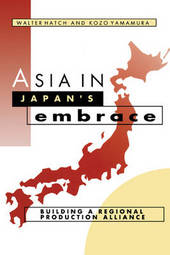
|
Asia in Japan's Embrace: Building a Regional Production Alliance
Paperback / softback
Main Details
| Title |
Asia in Japan's Embrace: Building a Regional Production Alliance
|
| Authors and Contributors |
By (author) Walter Hatch
|
|
By (author) Kozo Yamamura
|
| Series | Cambridge Asia-Pacific Studies |
|---|
| Physical Properties |
| Format:Paperback / softback | | Pages:298 | | Dimensions(mm): Height 229,Width 152 |
|
| Category/Genre | International economics |
|---|
| ISBN/Barcode |
9780521565158
|
| Classifications | Dewey:337.5205 |
|---|
| Audience | | Professional & Vocational | | Tertiary Education (US: College) | |
|---|
| Illustrations |
10 Line drawings, unspecified
|
|
Publishing Details |
| Publisher |
Cambridge University Press
|
| Imprint |
Cambridge University Press
|
| Publication Date |
28 June 1996 |
| Publication Country |
United Kingdom
|
Description
This book is an incisive analysis of Japan's deepening economic presence in Asia. It challenges neoclassical economists, arguing that instead of simply building a 'yen bloc' or responding to market forces, Japanese business and government elites are working together to build an expanded - and potentially exclusive - production zone. The authors suggest that the transplantation of many standard Japanese business practices in Asia is based on the concept of keiretsu (enterprise group) which allows a complex web of production networks to develop. The book shows that such strategic control of technology is a unique model of globalisation. While informed by economic theory, Asia in Japan's Embrace is highly accessible, containing interviews and anecdotal evidence from factory floors and board rooms. It is up-to-date, comprehensive and controversial, outlining policy implications and the impact on global trade.
Reviews'Readers familiar with recent writings on Japan will find this book steers a middle course between the neoclassical view, which denies Japan's uniqueness, and the revisionist arguments pioneered by Chalmers Johnson and emphasised by James Fallows. The book is easy to read, well-written, and carefully explained. When it uses concepts or terms such as keiretsu it is careful to explain them. The first four chapters, in particular, are to be recommended to all readers.' Salim Rashid, The Economic Journal
|